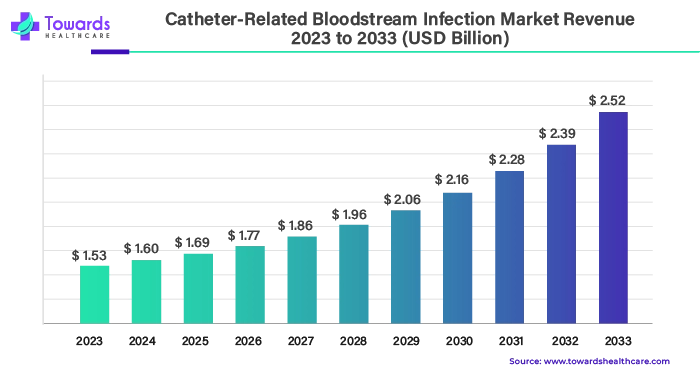April 2025

The catheter related bloodstream infection market was valued at US$ 1.53 billion in 2023 and is predicted to reach US$ 2.52 billion by the end of 2033, representing an impressive CAGR of 5.13% from 2024 to 2033. The increasing geriatric population and chronic conditions are driving the growth of the market.

The catheter related bloodstream infection market functions to provide treatment, medication, and other resources for monitoring and treating bloodstream infections that occur due to catheters. Catheters are tubes made out of silicone, Teflon, or latex that are inserted in the body for draining or feeding fluid. Some of the major applications of catheters include feeding, fluid drainage from wounds, and draining of the bladder. Catheter-related bloodstream infection is the presence of bacteremia that originated from an intravenous catheter. Such infections are very frequent, lethal, and costly. As the number of chronic diseases and the old-age population increase, the number of surgeries also increases. The need for catheters is also increasing due to surgeries. Along with the technological advancements and continuous research, it promotes the growth of the catheter related bloodstream infection market.
| Company Name | Citius Pharma |
| Headquarters | New Jersey, U.S. |
| Pipeline | For patients suffering from bloodstream infections linked to catheters (CRBSIs) or central line-associated bloodstream infections (CLABSIs), Mino-Lok® is an antibiotic lock solution. In colonized CVC salvage, Mino-Lok® showed 100% effectiveness in a Phase 2b study. Currently, a multicenter Phase 3 pivotal superiority study is being conducted. The FDA awarded Mino-Lok® QIDP and Fast Track status, and the company is protected by patents through 2024 and through 2036 for formulation patents. |
| Company Name | CorMedix |
| Headquarters | New Jersey, U.S. |
| Recent Development | In November 2023, a central venous catheter (CVC) is used to provide chronic hemodialysis to adult patients with renal failure, and the FDA approved the DefenCath® catheter lock solution to lower the incidence of CRBSI within this patient population. Taurolidine is an antibacterial thiadiazinane, and heparin is an anticoagulant that works together to form DefenCath. Numerous bacteria have been demonstrated to be susceptible to the effects of taurolidine. |

The elderly population, particularly those receiving care in the intensive care unit, is susceptible to CRBSIs due to a variety of causes. People may develop a range of geriatric traits as they become older, which may affect how they react to medications, such as antibiotics. The body's response to antibiotics can be influenced by a number of factors, including reduced immunity, renal impairment, decreased cardiac output, vascular complications, comorbid disorders, many concurrent drugs, elevated INR, emergently implanted CVC, thin skin/fragile veins, and cognitive problems. These variables may impact antibiotic filtration, efficacy, and entry points, for instance. They may also raise the risk of infection and conceal infection signs and symptoms. When prescribing antibiotics for senior patients, healthcare practitioners should take into account these specific geriatric traits and reactions to guarantee the most effective and safe course of therapy. The catheter related bloodstream infection market is expanding as a result of all these causes.
The primary worldwide danger to public health and development is antimicrobial resistance, or AMR. An estimated 4.95 million fatalities worldwide in 2019 were caused by bacterial AMR, of which 1.27 million were directly attributable to it. Drug-resistant infections mostly arise as a result of the abuse and overuse of antibiotics in people, animals, and vegetation. It increases the danger of chemotherapy for cancer, cesarean sections, and other medical operations and therapies, and makes infections more difficult to cure.
There is an urgent need for further steps to provide fair access to new and current vaccinations, diagnostics, and treatments in light of the escalating levels of resistance, as well as an inadequate pipeline for research and development. According to World Bank projections, AMR could cost US$ 1 trillion more in healthcare by 2050 and cause annual losses in GDP of US$ 1 trillion to US$ 3.4 trillion by 2030.
Preventing all infections, administering antibiotics, and putting strategic information and innovation into practice, such as surveillance of antimicrobial consumption and usage and research and development for innovative vaccines, diagnostics, and medications—are priorities for addressing antimicrobial resistance (AMR) in human health.
New methods have been developed to prevent CRBSIs and clinical trials have shown them to be effective in reducing the risk of CRBSIs. Lonic silver, anticoagulant/antimicrobial irrigation, new aseptic hub design and antimicrobial impregnation of catheters and dressings are some of the emerging technologies that can grow the catheter related bloodstream infection market in the coming years. In its ionic form, silver has a broad spectrum antimicrobial effect against bacteria and fungi. Antimicrobial irrigation solutions, often consisting of an anticoagulant and an antimicrobial agent, were used to fill the catheter cavity at least once a day. This procedure has been used mainly in long-term catheters, where central and luminal colonization are the main causes of CRBSI. A new antiseptic umbilical dressing has been developed to protect the umbilical cord and cavity from contamination. This design is used to anchor the catheter to the hub and has been shown in animal studies to prevent catheter colonization.
By treatment type, the anti-microbial agents segment dominated the catheter related bloodstream infection market in 2023. If CRBSI is suspected, especially if it is linked to sepsis or septic shock (B-II), antimicrobial treatment with a bactericidal agent active against S. aureus and CoNS should be started as soon as feasible. For empirical treatment, vancomycin is advised for individuals with suspected CRBSI (B-II). The two primary approaches to infection control are targeted antimicrobial therapy and empiric antimicrobial therapy. Numerous antibiotic drugs, including clindamycin, cefazolin, and vancomycin, have been used. Candida species can occasionally be resistant to amphotericin B and fluconazole, which are important antimicrobial agents. Appropriate antimicrobial medicines are used to treat patients with CRBIs for a minimum of four weeks. There are two types of antibacterial therapies: oral and IV, with oral being the most common. When compared to IV treatment delivered via CVCs, oral therapy offers a number of significant advantages. Phlebitis CVC line infections can be eradicated as one of the clinical benefits of oral antibiotic treatment. The acquisition costs of oral medicines are lower than those of their intravenous equivalents at equal dosages.
By source of infection, the Coagulase-negative Staphylococcus segment dominated the catheter related bloodstream infection market in 2023. Clinical recommendations state that removal of the catheter and antibiotic therapy for 5-7 days are the recommended courses of treatment for CRBSI caused by coagulase-negative staphylococci (CoNS). Approximately 80% of patients admitted to a medical ward have one or more catheters implanted at the time of admission, with 95% of those catheters being short-term peripheral ones, according to a recent research. 15–30% of nosocomial bacteremia cases are caused by vascular catheters, making them one of the most frequent causes. When treating CNS infections, doctors frequently start with an extremely potent antibiotic called vancomycin. This drug is often administered via an IV. They can then select a more effective antibiotic by using the antibiotic data. The more recent antibiotics daptomycin, linezolid, clindamycin, telavancin, tedizolid, and dalbavancin are active against coagulase-negative staphylococci. Deep-seated infections can benefit from the use of gentamicin or rifampicin.
By distribution channel, the hospital pharmacies segment dominated the catheter related bloodstream infection market. Hospital pharmacies are located inside medical facilities and offer both inpatients and outpatients prescription drugs as well as clinical services. Hospital pharmacists collaborate closely with other healthcare providers in a setting that is more clinical in nature. Medical personnel receive direct clinical support from hospital pharmacists. They take part in patient rounds, make appropriate pharmacological therapy recommendations, and modify prescription schedules in response to test data and patient responses.
Throughout the hospital, hospital pharmacists are in charge of ensuring that pharmaceuticals are used safely and effectively. Particularly around the time of discharge, hospital pharmacists instruct patients on their drugs. They cover potential side effects, make sure patients understand their treatment regimens, and give advice on how to take medications at home. Hospital pharmacists contribute to the overall quality of care by keeping an eye on and reporting adverse drug reactions, protecting patient safety.
By distribution channel, the online pharmacies segment is anticipated to show significant growth during the forecast period. Purchasing prescription medication from E-Pharmacy is a fairly simple process. This approach is an incredibly simple and quick way to get medication, especially for those who live far from a typical pharmacy, are elderly or disabled, or work long hours. Going to a typical pharmacy is far more expensive than the delivery fee. E-Pharmacy application's time-saving features are among its most significant benefits.
It is possible to place an order for medication and receive prescription drugs in a matter of minutes. All you need to do is use the website or mobile application to enter the prescription and place an order. There is no need to visit the drugstore and there won't be a lineup. Patients greatly benefit from e-pharmacy, which offers a far greater selection of alternatives than a traditional pharmacy. All these factors contribute to the growth of online pharmacies in the catheter related bloodstream infection market.
By region, North America dominated the catheter related bloodstream infection market in 2023. The major factors that lead to the growth of the market in North America include technological advancements, better healthcare resources, better healthcare infrastructure and government initiatives. The U.S. and Canada are the two major countries that contribute to the growth.
Apart from better research & development, advanced healthcare infrastructure, and better resources, increasing old age population and chronic disorders are contributing to the growth of the catheter related bloodstream infection market in the U.S.. According to projections, the number of Americans 65 and over will climb by 47%, from 58 million in 2022 to 82 million in 2050. Additionally, the share of this age group in the overall population is expected to increase from 17% to 23%. Based on the definition provided by the U.S. Department of Health and Human Services, an estimated 129 million Americans suffer from at least one serious chronic illness (heart disease, cancer, diabetes, obesity, or hypertension). In America, a growing percentage of people (42%) have two or more chronic diseases, and 12% have five or more.
In addition to its effects on the individual, chronic illness has a significant influence on the US healthcare system. Approximately 90% of the $4.1 trillion spent on health care each year goes toward treating and managing mental health issues and chronic illnesses. During a patient's hospital stay, CRBSI frequently results in morbidity and death. Every year, 80,000 new cases of central line-associated bloodstream infections (CLABSI) are reported in the U.S.. These infections are linked to higher rates of death and higher economic expenses (39,000 US dollars each episode).
By region, Asia Pacific is expected to be the fastest-growing region during the forecast period. The major countries that contribute to the growth of the catheter related bloodstream infection market are China, India, Japan and North Korea.
The healthcare industry in India has grown to be one of the most significant in the country in terms of jobs and income. In 2022, the healthcare sector in India was valued at more than $370 billion. By 2026, the healthcare sector is projected to generate approximately $610 billion in revenue. In an effort to improve the safety, efficacy, and conformity of medicines, medical devices, and cosmetics sold in India with international standards, the Ministry of Health and Family Welfare (MoHFW) released the New Drugs, Medical Devices, and Cosmetics bill in July 2022, replacing the D&C Act.
By Treatment Type
By Source of Infection
By Distribution Channel
By Region
April 2025